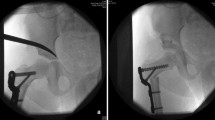Abstract
Background
Children with early Perthes’ disease and clinical loss of motion are commonly noted to have normal or almost normal hip range of motion (ROM) when examined under anesthesia (EUA). Despite anecdotal comments about this observation, no series has documented these findings. The lack of such data led to this study.
Methods
Consecutive patients with unilateral Herring class B or C Perthes’ disease in mid to late Waldenstrom’s fragmentation stages who failed a non-operative course of hip motion restoration had hip range of motion (ROM) documented pre-operatively and intra-operatively by a single, experienced pediatric orthopedic surgeon. The opposite normal hip’s ROM was used as the control. Joint congruity was assessed arthrographically.
Results
Twenty-seven patients, 6–10 years old (average 7.9 years) with early Perthes’ disease were reviewed. Twenty-one of 27 patients (77.7%) had full or almost full hip ROM of the involved side when examined under anesthesia (EUA). Six patients (22.3%) had limited abduction (<50 degrees) and underwent an adductor tenotomy that normalized hip ROM. Five of these six patients were older than 8 years. Intra-operative arthrography did not demonstrate lack of containment, hinge abduction or joint incongruity.
Conclusions
Loss of hip ROM in this series of patients with early Perthes’ disease without intra-articular incongruity was due to pain and muscle spasm which were obviated by anesthesia, demonstrating essentially normal hip ROM in the majority of patients. Pre-operative bed rest and traction was not required to restore ROM in this group of patients.
Similar content being viewed by others
References
Herring JA (1996) Management of Perthes’ Disease. J Pediatr Orthop 16:1–2
Killian JT, Ryoppy S (1985) Hyperpressure in juvenile hip disease. Acta Orthop Scand 56(3):211–214
Reinker KA (1996) Early diagnosis and treatment of hinge abduction in Legg-Perthes disease. J Pediatr Orthop 16(1):3–9
Serlo W, Heikkinen E, Puranen J (1987) Preoperative Russell traction in Legg-Calve-Perthes disease. J Pediatr Orthop 7(3):288–290
Perthes G (1913) Uber Osteochondritis Deformans Juveniles. Anch Klin Chir 101:779–784
Kallio P, Ryoppy S (1985) Hyperpressure in juvenile hip disease. Acta Orthop Scand 56(3):211–214
Richards BS, Coleman SS (1987) Subluxation of the femoral head in coxa plana. J Bone Joint Surg Am 69(9):1312–1318
Petrie JG, Bitenc I (1971) The abduction weight-bearing treatment in Legg-Perthes’ Disease. J Bone Joint Surg Br 53(1):54–62
Lloyd-Roberts GC, Catterall A, Salamon PB (1976) A controlled study of the indications for and the results of femoral osteotomy in Perthes’ Disease. J Bone Joint Surg Br 58(1):31–36
Author information
Authors and Affiliations
Corresponding author
Additional information
The author has received no financial support for this study.
About this article
Cite this article
Stanitski, C.L. Hip range of motion in Perthes’ disease: comparison of pre-operative and intra-operative values. J Child Orthop 1, 33–35 (2007). https://doi.org/10.1007/s11832-007-0009-5
Received:
Accepted:
Published:
Issue Date:
DOI: https://doi.org/10.1007/s11832-007-0009-5




